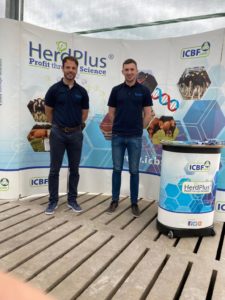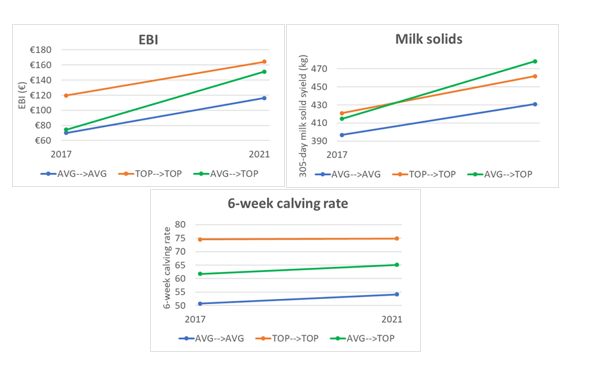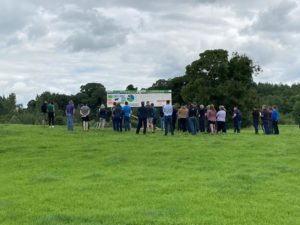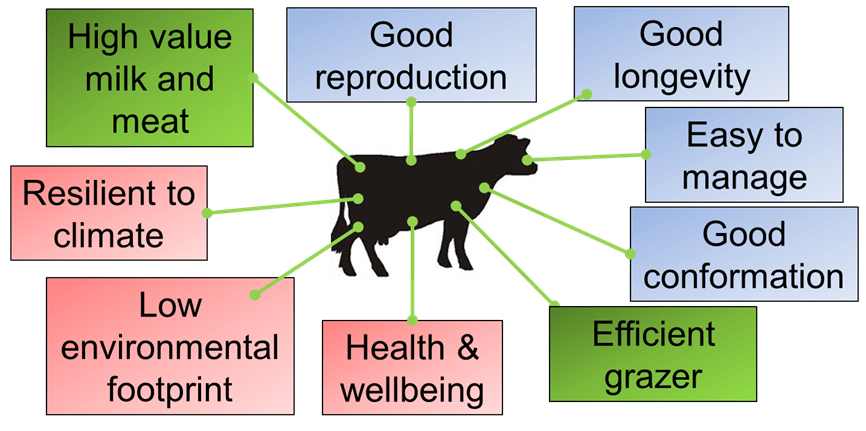ICBF were delighted to attend the recent Ballyhaise Open Day on Wednesday 13th July at Ballyhaise Agricultural College, Co. Cavan. Members of the HerdPlus team were on hand to answer all breeding-related questions throughout the day.
were delighted to attend the recent Ballyhaise Open Day on Wednesday 13th July at Ballyhaise Agricultural College, Co. Cavan. Members of the HerdPlus team were on hand to answer all breeding-related questions throughout the day.
‘Futureproofing Irish Dairying’ was the theme of this year’s event. Irish Dairy farmers have expanded significantly since the abolition of milk quotas in 2015 and this has made a very significant addition to family farm income in rural communities throughout Ireland, and in particular, in the Border Midlands and Western region. Future development of the dairy industry will require a close alignment with EU and national policy objectives, with a particular focus on reduced carbon emissions and improved water and air quality and biodiversity.
Ballyhaise’22 highlighted the various technologies and practices available to farmers to underpin future farm profitability and sustainability.
ICBF was involved in data analysis on the performance of herds in the Border, Midlands and Western (BMW) region. It was clear from the analysis that higher EBI herds outperform their lower EBI contemporaries, confirming the relevance and importance of the EBI for breeding the cow of the future.
EBI is as relevant tomorrow as it is today
James Dunne1, 2, George Ramsbottom, Kevin Downing3 & Donagh Berry2
1Teagasc Ballyhaise College, Co. Cavan
2Teagasc, Animal and Grassland Research and Innovation Centre, Moorepark, Fermoy, Co. Cork
3Irish Cattle Breeding Federation, Link Rd, Ballincollig, Co. Cork
Introduction
The Economic Breeding Index (EBI) summarises the expected performance of an animal’s progeny for a range of characteristics into a single value. Both bulls and cows receive an EBI value. The EBI is useful for comparing which cows to breed from and which dairy bulls to use. The daughters of a bull with an EBI of €300 are expected to be, on average, €50 more profitable per lactation (i.e., >€200 per lifetime) than the daughters of a bull with an EBI of €250. The EBI itself is comprised of seven sub-indexes of which profit from milk (i.e., milk sub-index) and profit fertility (i.e., fertility sub-index) constitute two thirds of the emphasis. In fact, there is currently 19 traits in the EBI. The EBI must always be forward thinking – the EBI bred for A+B-C milk pricing well before processors adopted this payment system. The significance of being forward thinking is as important today as it has been heretofore.
Figure 1. Characteristics of the ideal cow of the future
The characteristics of the dairy cow of the future are in Figure 1. The characteristics highlighted in green are those that are well covered in the EBI; those in blue, while included in the EBI, can be improved and those in red require attention. Nonetheless, indirect improvement in the traits in red continue to be realised without explicit inclusion in the EBI. For example, the carbon efficiency of milk production has improved 14% per unit milk solids since the introduction of the EBI.
EBI in the BMW Region
An analysis of herd performance in the Border Midlands and Western region was undertaken based on the change in herd EBI between the years 2017 and 2021. Three categories of herds were formed: 1) herds that were categorised average for EBI in 2017 and remained in the average EBI category in 2021 (AVG–>AVG), 2) herds that were in the top 20% for EBI in 2017 and remained in the top 20% on EBI in 2021 (TOP–>TOP), and 3) herds that were average for herd EBI in 2017 but moved into the top 20% for EBI in 2021 (AVG–>TOP). No differentiation was made on cow breed since the EBI works across breed. Performance metrics of the herds is in Figure 2. Figure 2. Change in herd EBI, 305-day milk solids yield and 6-week calving rate for AVG–>AVG, TOP–>TOP and AVG–>TOP farms in the BMW region.
Figure 2. Change in herd EBI, 305-day milk solids yield and 6-week calving rate for AVG–>AVG, TOP–>TOP and AVG–>TOP farms in the BMW region.
The average EBI of the AVG–>AVG and TOP–>TOP groups increased by €45 between 2017 and 2021 while that of the AVG–>TOP increased by €77. Milk solids per lactation increased by 9% and 10% for the AVG–>AVG and TOP–>TOP groups, respectively while that of the AVG–>TOP increased by 15%. Irrespective, the mean milk solids yield per lactation of the two TOP groups in 2021 was 7% to 11% higher than the AVG group in 2021. The 6-week calving rate of the TOP–>TOP group did not change over the four years albeit it already was achieving 75% (calving interval of 379 days); the 6-week calving rate of the AVG–>TOP group in 2021 was 65% (calving interval of 385 days) while that of the AVG–>AVG group was 54% (calving interval of 401 days).
A further analysis was undertaken using e-profit monitor data from 262 farms in the catchment from the years 2018 to 2021 relating herd EBI to profit per lactation. Each €1 increase in herd EBI was associated with €1.79 more profit per lactation. This is similar to the response observed for many years across the country as a whole. In other words, due to the increase in herd EBI within the AVG–>TOP herds (increase of €77 over the period 2017 -2021) profit per lactation is expected to have increased by €137.80. Assuming an average herd size of 89, this difference equates to €12,264 more profit per year. Compare this to the €45 EBI gain made with the AVG–>AVG group over the same period which equates to €80.50 additional profit per lactation or €7,164 more profit per year.
Conclusion
Many studies have now clearly demonstrated the applicability of EBI in improving herd profit. The present study substantiated this claim even when limited to suppliers in the Ballyhaise catchment area, while also proving the suitability of high EBI genetics on heavier land types.
Summary
- The applicability of the EBI to dairy farmers in the BMW Region is demonstrated
- Higher EBI herds outperform their lower EBI contemporaries
- Each €1 change in herd EBI is associated with €1.79 more profit per lactation


